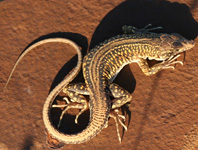Abstract
Scapulocoracoid variation in Sympterygia acuta and S. bonapartii was analyzed inter- and intraspecifically, and the utility of this structure as a diagnostic character in skates was evaluated. Skeletal pieces were obtained from a total of 85 specimens collected in coastal waters of northern Argentina in 2011 and 2012. Morphometric variation was analyzed using non parametric tests. Morphologic variation was qualitatively and quantitatively evaluated by comparing number, shape and arrangement of posterior fenestrae. Scapulocoracoids of both species are rectangular in shape and expanded anteroposteriorly, but those of S. bonapartii were more expanded. Differences in shape, both in males and females, were reflected in the ANOSIM test. Greatest Height and Height of Rear Corner were the variables that most contributed to the differences found between both species. These differences in morphology agree with previous descriptions. No sexual dimorphism was observed regarding scapulocoracoids in S. acuta, and only a slight variation between males and females of S. bonapartii was found. Number of postdorsal and postventral fenestrae was highly variable. At least five scapulocoracoid morphotypes for S. acuta (with two to six fenestrae) and seven scapulocoracoid morphotypes for S. bonapartii (with three up to nine fenestrae) were identified. However, patterns of fenestrae arrangement were also very diverse in both species. Therefore, a broad variation in fenestrae number and pattern, especially postdorsal ones, was shown in both species. These results indicate that caution needs to be taken when using the scapulocoracoids not only in phylogenetic studies but also in descriptions of new species.
References
de Carvalho, M.R., Gomes, U.L. & Gadig, O.B.F. (2005) Description of a new species of skate of the genus Malacoraja Stehmann, 1970: the first species from the southwestern Atlantic Ocean, with notes on generic monophyly and composition (Chondrichthyes: Rajidae). Neotropical Ichthyology, 3, 239–258.
https://doi.org/10.1590/S1679-62252005000200002Compagno, L.J.V. (1999) Endoskeleton. In: Hamlett, W.C. (Ed.), Sharks, Skates and Rays: The Biology of Elasmobranch Fishes. The Johns Hopkins University Press, Baltimore, Maryland, pp. 69–92.
Dolganov, V.N. (2002) The Origin and Distribution of the Suborder Rajoidei in the World Ocean. Journal of Ichthyology, 42, 21–22. [S21–S22]
Ebert, D.A. & Compagno, L.J.V. (2007) Biodiversity and systematics of skates (Chondrichthyes: Rajiformes: Rajoidei). Environmental Biology of Fishes, 80, 111–124.
https://doi.org/10.1007/s10641-007-9247-0Garman, S. (1837) On the pelvis and external sexual organs of selachians, with especial references to the new genera Potamotrygon and Disceus (with descriptions). Proceedings of the Boston Society of Natural History, 1837, 197–215.
Hulley, P.A. (1972) The origin, interrelationships and distribution of South African Rajidae (Chondrichthyes: Batoidei). Annale Van Die Suid-Afrikaanse Museum, 60, 1–103.
Jeong, C.H. & Nakabo, T. (2009) Hongeo, a new skate genus (Chondrichthyes: Rajidae), with redescription of the type species. Ichthyological Research, 56, 140–155.
https://doi.org/10.1007/s10228-008-0083-9Last, P.R. & Gledhill, D.C. (2007) The Maugean Skate, Zearaja maugeana sp. nov. (Rajiformes: Rajidae) –A micro-endemic, Gondwanan relict from Tasmanian estuaries. Zootaxa, 1494 (65), 45–65.
Last, P.R. & McEachran, J.D. (2006) Notoraja hirticauda, a new species of skate (Chondrichthyes : Rajoidei) from the south-eastern Indian Ocean. Memoirs of the Museum Victoria, 63 (1), 65–75.
https://doi.org/10.24199/j.mmv.2006.63.9Mabragaña, E. (2007) Las Rayas del Género Psammobatis de la plataforma Argentina: biología y ecología. Tesis doctoral, Universidad Nacional de Mar del Plata, Mar del Plata, 178 pp.
McEachran, J.D. (1982) Revision of the South American skate genus Sympterygia (Elasmobranchii, Rajiformes). Copeia, 4, 867–890.
https://doi.org/10.2307/1444098McEachran, J.D. (1983) Results of the research cruises of FRV “Walter Herwig” to South America LXI. Revision of the South American skate genus Psammobatis Günther, 1873 (Elasmobranchii, Rajiformes, Rajidae). Archiv für Fischereiwissenschaft, 34, 23–80.
McEachran, J.D. & Compagno, L.J.V. (1979) A further description of Gurgesiella furvesens with comments on the interrelationships of Gurgesiellidae and Pseudorajidae (Pisces, Rajoidei). Bulletin of Marine Science, 29, 530–553.
McEachran, J.D. & Compagno, L.J.V. (1982) Interrelationships of and within Breviraja based on anatomical structures (Pisces: Rajoidei). Bulletin of Marine Science, 32, 399–425.
McEachran, J.D. & Dunn, K.A. (1998) Phylogenetic Analysis of Skates, a Morphologically Conservative Clade of Elasmobranchs (Chondrichthyes: Rajidae). Copeia, 1998 (2), 271–290.
https://doi.org/10.2307/1447424McEachran, J.D. & Last, P.R. (1994) New species of Skate, Notoraja ochroderma, from off Queensland, Australia, with comments on the taxonomic limits of Notoraja (Chondrichthyes, Rajoidei). Copeia, 1994 (2), 413–421. https://doi.org/10.2307/1446989
McEachran, J.D. & Miyake, T. (1990) Phylogenetic Interrelationships of Skates: A Working Hipothesis (Condrichthyes: Rajoidei). In: Pratt, H.L., Gruber, S.H. & Taniuchi, T. (Eds.), Elasmobranchs as living resources: advances in the biology, ecology, systematics and the status of fisheries. NOAA Technical Report, NMFS 90, pp. 285–304.
Müller, J. & Henle, F.G.J. (1841) Systematische Beschreibung der Plagiostomen der Knorpelfische. Veit, Berlin, xxii + 200 pp.
Naylor, G.J.P., Caira, J.N., Jensen, K., Rosana, K.A.M., White, W.T. & Last, P.R. (2012) A DNA Sequence-Based Approach To the Identification of Shark and Ray Species and Its Implications for Global Elasmobranch Diversity and Parasitology. Bulletin of the American Museum of Natural History, 367, 1–262.
https://doi.org/10.1206/754.1R Core Team (2014) R: A language and environment for statistical computing. R Foundation, Vienna, Austria. Available from: http://www.r-project.org/ (accessed 31 July 2017)
Stehmann, M. (1970) Vergleichend morphologische und anatomische Untersuchungen zur Neuordnung der Systematik der nordostatlantischen Rajidae (Chondrichthyes, Batoidei). Archiv für Fischereiwissenschaft, 21, 73–164.
Stehmann, M. & Seret, B. (1983) A new species of deep-water skate, Breviraja africana sp. n. (Pisces, Batoidea, Wajidae), from the Eastern Central Atlantic slope, and remarks on the taxonomic status of Breviraja Bigalow & Schroeder, 1948. Bulletin du Muséum national d’histoire naturelle, 5, 903–925.

